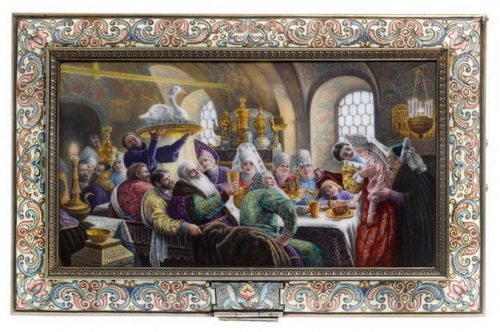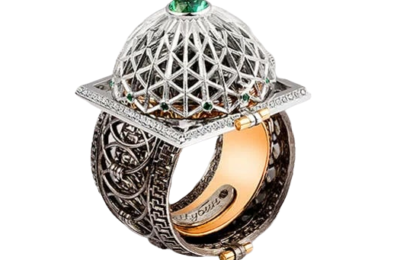
Fyodor Rückert – enamel painter
Fyodor Ivanovich Rückert, who collaborated with the tsarist jeweler Karl Faberge, was rightfully called the “enamel painter.” He became famous for his silver works in the “original Russian style” at the turn of the last century, decorated with polychrome enamels on filigree and miniature pictorial compositions on the theme of Russian history and ancient life.
The legacy of the master in the state museums of Russia is small and has no more than two dozen items. In Russia, not a single work about the famous enamel was published, but according to the recollections of the descendants of Fyodor Ivanovich, who live in Moscow and cherish family memory, it was possible in general terms to restore the history of his workshop. Fyodor Rückert, who subtly felt the beauty and poetry of Russian art, was a German by origin and Prussian subjects.

Biography Fyodor Rückert
According to family traditions, Friedrich Moritz Rückert was born in Alsace-Lorraine in 1840 and came to Russia at the age of 11-13. Subsequently, he did not receive Russian citizenship, like his children from his first marriage. He spent his youth under the patronage of Prince Galitsin, who brought him to Russia as an engraver, together with Emil. In 1850 Fyodor Rückert married Emil with the blessing of the prince.
His first wife, a German, was one of the best seamstresses and they lived comfortably. Their first child, Adele (1860 – 1938), was born in 1860, then 13 years later Ida (1873-1958), Pavel (1880 – 1922), Alexander (1882 -?) And Peter (1888 -?) Fedor Rückert taught all his children to work in the workshop, they grinded and tortured enamels, helped the craftsmen, and learned the basics of the craft. He paid special attention to his son Pavel, whom everyone in the family considered to be his father’s successor.

It was he who subsequently made fundamental changes in the style of the company, a change in color scheme, complicated the ornaments and, in general, reflected in the style a more cosmogonic beginning. 1886 Rückert opens a workshop, the exact date is indicated on the donated salary for the anniversary of the company.

Faberge Treaty
And already in 1887 an agreement was signed with Faberge. From that moment on, Fyodor Ivanovich took a house on Vorontsovskaya from Sokolov for rent. Most of the workshops were on the ground floor. Initially, Rückert produced the bulk of his products for Faberge. It was around 80%. Later, he became a supplier for the firms of Marshak and Kurlikov.
The workshop did not have its own shops. The center of the house was a room on the second floor with a tiled fireplace and the largest window, it was there that Rückert spent long hours with Faberge, discussing projects, and on the second floor there were offices for design, drawing and negotiations.

Despite the fact that at the best of times the company employed only forty people, sales of Rkzhkert’s products were quite large, because he supplied his wares to other large firms and shops, as well as to Faberge. As an independent silversmith in Moscow, he created wares in the old Russian style. Despite the fact that Faberge had workshops in Moscow, none of the enamel work was done there.
The entire Ruckert family lived in the house on Vorontsovskaya, except for two daughters, Ida and Adele. The left side of the house was given to the craftsmen, where they lived with their families. the first wife of Fyodor Ivanovich dies.

Second marriage
After the death of his first wife, Fedor Ivanovich married Evgenia Kalistratovna Belova, a native of Smolensk, the daughter of a glass-blower who worked at a factory in Bolshaya Vishera.
In this marriage were born sons Fedor, Anatoly, Alexander, Eugene, daughters Maria and Sophia – Orthodox, like their mother. The daughters of Fyodor Ivanovich received a good education.

Ida taught German, played in amateur theater and was a good pianist. Sophia graduated from a higher trade school, and at the same time she was fluent in enamel technique. The eldest, Adel Fedorovna, worked for many years as a midwife in the famous Moscow maternity hospital of Grauerman, and then served as a governess for a famous doctor
Around 1904, his second wife dies. And Fyodor Ivanovich is getting married again. His third wife dies around 1950.
The sons worked in their father’s workshop, where, in addition to them, according to relatives, there were also apprentice boys who lived nearby.

Father’s work is continued by son Pavel
Pavel and Fyodor studied at the Imperial Stroganov Central School of Industrial Art. Since the 1900s, Fyodor Ivanovich, being in old age, transfers his affairs to his son Pavel. Son Eugene was least of all connected with work in his father’s workshop. He was a pianist, together with his sister Ida he played in an amateur theater at the gold-caning factory, which was organized by the famous K. Stanislavsky.
Fyodor Ivanovich died in 1917, his grave is at the Vvedenskoye cemetery in Moscow. Rückert’s workshop became famous for its amazing enamel painting, which captured the beauty and charm of Russian antiquity.

Works of the master, photo




















